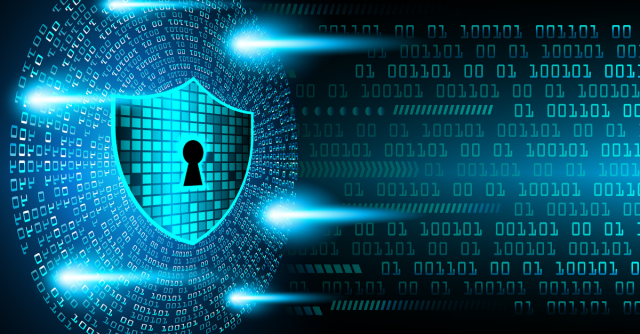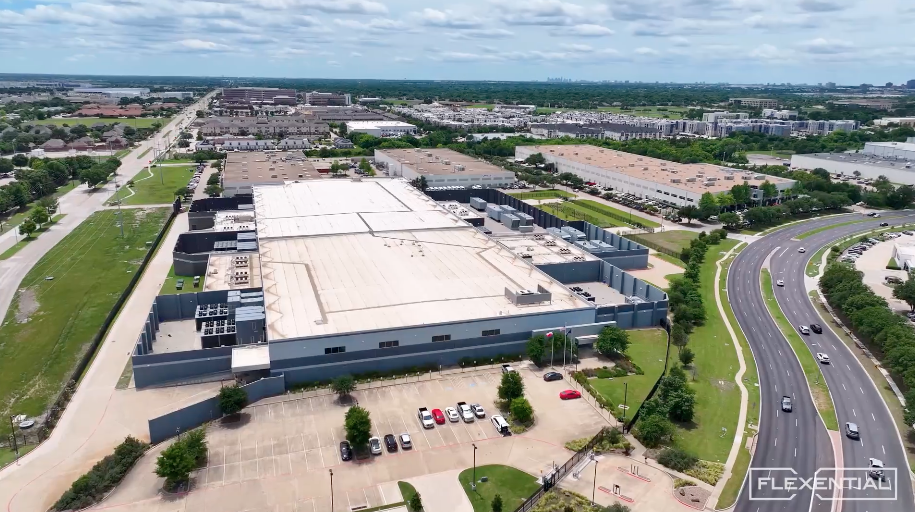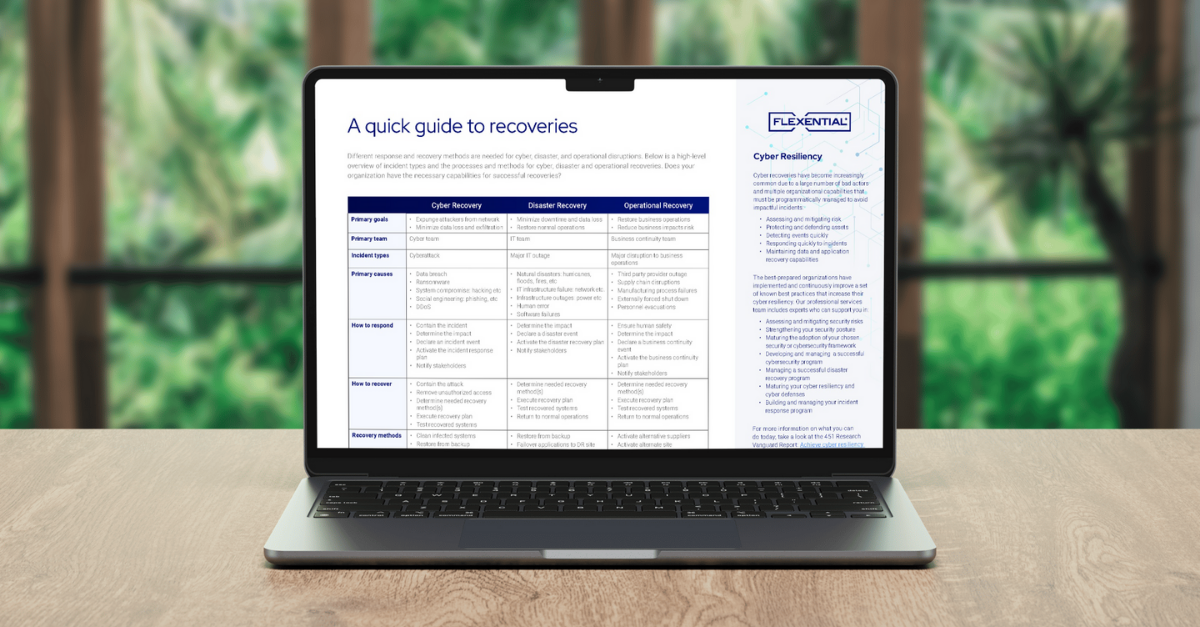What is cyber resilience?
Cyber resilience isn’t just a buzzword—it’s a necessity. As attacks become more sophisticated and frequent, a strong defense alone won't protect your organization. You also need the ability to respond and recover quickly to maintain operations.

At its core, cyber resilience brings together cybersecurity and business continuity. It goes beyond protection to ensure your organization stays operational even under attack. This is why forward-thinking IT leaders are reimagining their cybersecurity services with resilience as the foundation.
Introduction to cyber resilience
Definition and key concepts
Cyber resilience is your organization's ability to prepare for, respond to, and recover from cyber threats without business interruption. It integrates cybersecurity, IT resilience, and business continuity strategies to minimize disruption during incidents.
Unlike traditional cybersecurity that aims to stop all threats, cyber resilience takes a practical approach—acknowledging that some attacks will inevitably break through. This shifts your focus to containing damage and restoring operations rapidly.
Importance of cyber resilience in today’s digital world
Cyberattacks have become a constant reality, growing more targeted and sophisticated each day. Consider the real-world impact: ransomware shutting down critical healthcare services or supply chain breaches affecting thousands of businesses simultaneously.
This is why cyber resilience matters to your organization. It goes beyond protecting systems—it safeguards your people, data, and the services you provide to customers. With a strong resilience strategy, you can keep operating during an attack, protect your reputation, and significantly reduce the lasting damage when threats inevitably break through.
Overview of the Cyber Resilience Act (CRA)
The Cyber Resilience Act (CRA) represents the European Union's initiative to strengthen cybersecurity for digital products. At its heart, the CRA requires hardware and software to include security and resilience by design—not as features tacked on later.
Under this regulation, companies must implement specific practices, including secure development processes, vulnerability management programs, and incident reporting protocols. The CRA covers everything from consumer smart devices to complex enterprise software and infrastructure.
Though originating in the EU, the CRA will affect businesses worldwide. If your company offers digital products in EU markets—or sells to customers with European operations—you'll need to ensure compliance.
This regulation signals a fundamental shift in how we approach security in product development. It acknowledges what security professionals have long advocated: true resilience must be built into products from day one, not added as an afterthought.
Components of cyber resilience
IT resilience vs. cyber resilience
IT resilience and cyber resilience are often confused, but they aren’t the same. IT resilience concentrates on maintaining system operations during technical failures, outages, or data loss incidents. Cyber resilience encompasses this foundation but expands to address malicious threats—cyberattacks, data breaches, and the constantly changing threat landscape.
Put simply: IT resilience helps your systems stay available during accidents or failures. Cyber resilience ensures your business can recover when someone deliberately tries to disrupt your operations.
Risk management and assessment
Cyber resilience starts with identifying risk. This process examines both technical vulnerabilities—such as unpatched systems or misconfigured security controls—and operational weaknesses like staff training gaps or risks from third-party vendors.
When you implement a structured risk assessment process, your team can efficiently prioritize and fix vulnerabilities before attackers exploit them. This approach also gives you clearer visibility into your security posture and helps you make smarter decisions about where to invest your limited security resources.
Incident response and recovery planning
No matter how strong your defenses, breaches can still occur. A well-defined incident response plan gives your team clarity about roles, responsibilities, timelines, and communication protocols during a security crisis.
Developing an incident response plan
An effective incident response plan clearly defines each team member's role, establishes escalation paths, sets realistic timelines, and outlines communication protocols. To keep your plan relevant and practical, you need to review and test it regularly through tabletop exercises and simulations.
Key steps in recovery
Recovery involves much more than simply restoring your data. The goal is getting your business operations back up quickly and confidently. This requires regularly validated backup systems, clearly defined Recovery Point Objectives (RPOs) and Recovery Time Objectives (RTOs), and redundant systems designed to take over with minimal business disruption.
Ready to assess your cybersecurity maturity? Download our free white paper: Accelerate Your Cybersecurity Maturity Journey to evaluate your current security posture and create a roadmap for improvement.
Strategies for building cyber resilience
Prevention techniques
Though you can't prevent every attack, reducing your risk exposure creates a strong foundation. Your prevention strategy should start with policy enforcement, endpoint security, and access management controls. This approach also requires investing in infrastructure specifically designed to withstand disruptions and continue functioning during attacks.
Network security best practices
Implementing strong network security practices—from proper firewall configurations to multi-factor authentication—significantly reduces potential entry points for attackers targeting your systems. But technical controls alone aren't enough. Your people remain both your greatest vulnerability and strongest defense. Training your employees to recognize phishing attempts and social engineering tactics helps stop many attacks before they can gain a foothold in your network.
Importance of regular updates and patches
Unpatched vulnerabilities continue to be one of the most common entry points attackers exploit. Your security program needs to include comprehensive patch management that covers everything—operating systems, applications, plugins, firmware, and third-party tools. Remember that each unpatched system represents an open door to your network.
Detection and monitoring
You simply can't respond to threats you haven't detected. Effective detection depends on continuous, 24/7 monitoring of your environment to spot suspicious activities before they escalate into major incidents.
Role of AI and machine learning
Artificial intelligence and machine learning technologies now play a crucial role in detecting abnormal behavior patterns, identifying previously unknown threats, and reducing the alert fatigue that plagues many security teams. For deeper insights, check out how AI is transforming cybersecurity and review the latest trends on AI cybersecurity.
Importance of continuous monitoring
Your monitoring strategy should cover all potential attack surfaces—networks, cloud environments, user behaviors, and external threat intelligence. When you have visibility across your entire digital ecosystem, you can detect and contain threats much faster, often before significant damage occurs.
Response and recovery
While prevention and detection are critical components, your organization's true resilience becomes apparent when incidents occur. How quickly and effectively you respond and recover after a security breach ultimately defines your cyber resilience maturity.
Disaster recovery planning
A solid disaster recovery plan must include secure offsite backups, regularly tested failover systems, and business workflows designed to continue even during major disruptions. For more specific guidance on strengthening your infrastructure, read our post on fortifying cloud and colocation environments to build a more resilient foundation.
Post-incident analysis and improvement
Each security incident provides valuable lessons for your organization. Conducting thorough post-mortem reviews reveals what failed, what worked well, and specific areas for improvement. When you build structured feedback loops into your incident response process, you continuously strengthen your resilience and reduce the likelihood of facing similar incidents in the future.
Challenges in achieving cyber resiliency
Evolving threat landscape
Cyber threats are constantly shifting. Attackers constantly adapt their methods, now leveraging advanced techniques like AI-generated phishing campaigns and sophisticated supply chain compromises. Security controls that protected your systems just months ago might be ineffective against today's threats.
To maintain resilience, you need to stay current on threat intelligence, security tools, and testing methodologies. Your security strategy must remain flexible, allowing you to quickly pivot as new risks emerge.
Budget and resource constraints
Most organizations recognize why cyber resilience matters but face practical challenges in funding comprehensive programs. Security tools require significant investment. Qualified security talent remains scarce and costly. Meanwhile, daily operational demands compete for limited resources.
That’s why resilience efforts should start with high-impact actions. Start by addressing foundational security gaps, measure and communicate your progress clearly, and use these early wins to build internal support for continued investment in your resilience program.
Regulatory compliance
With regulations like GDPR, HIPAA, the Cyber Resilience Act, and countless industry-specific requirements, compliance demands have never been more complex. However, these regulations also create opportunities for improving your security posture.
When you align compliance activities with your broader resilience strategy, you simultaneously reduce risk exposure, prepare more effectively for audits, and demonstrate to stakeholders that security is a genuine priority. Rather than treating compliance as a separate checkbox exercise, integrate it into your overall security strategy for maximum benefit.
The role of technology in enhancing cyber resilience
Cloud solutions
Cloud platforms provide essential resilience capabilities through their inherent flexibility, scalability, and redundancy features. However, cloud environments still demand careful security configuration and continuous monitoring to protect your data.
Many organizations find that hybrid environments—combining cloud services with colocation facilities—offer the best balance of agility and control. Learn how AI and colocation solutions help businesses like yours improve performance while maintaining strong resilience against threats.
Automation and AI
Automation dramatically accelerates your response capabilities while reducing the risk of human error. From streamlining patch management to enhancing threat detection, automation helps your security team act decisively when minutes or even seconds matter.
AI capabilities take this advantage even further by analyzing massive datasets to identify emerging threats, detect subtle anomalies, and in some cases, automatically initiate containment measures. As covered in the evolution of AI and data security, these technologies are redefining what’s possible in both prevention and response.
Data encryption and protection
No resilience strategy is complete without strong data protection. Implementing encryption for data both at rest and in transit forms a critical foundation for securing sensitive information. Yet encryption by itself doesn't create resilience. You also need reliable, tested backup systems, secure storage solutions, and regular recovery testing to ensure your data restoration processes actually work when you need them most.
Are there cyber resilience solutions?
Yes—but there’s no one-size-fits-all answer. Instead, think of cyber resilience as a comprehensive strategy combining technology, processes, and people working together to reduce risk and enable swift recovery.
Your approach might include various security tools, redundant backup systems, cloud failover capabilities, and detailed incident response plans. Make sure to review the elements of a cybersecurity program to build resilience into every aspect of your security architecture—rather than trying to add it later.
Consider how external partners might strengthen your resilience posture. Many businesses work with specialized security firms to assess risks, test response plans, or manage specific security functions. These partnerships help fill internal skill gaps and accelerate your resilience journey.
The most effective solutions for your organization will support your specific business strategy—they must be scalable as you grow, regularly testable to verify effectiveness, and carefully aligned with your operational needs.
Future trends in IT and cyber resilience
The path forward for businesses and organizations
Cyber resilience has evolved beyond the exclusive domain of IT and security teams—it now requires collaboration across your entire organization. As cyber risks grow more complex, everything from business continuity to regulatory compliance and customer trust depends on your resilience capabilities.
AI will fundamentally transform how you detect and manage threats, but maintaining visibility across your environment remains crucial. As your systems become increasingly interconnected, you need comprehensive monitoring tools that provide insights across cloud services, colocation facilities, and edge computing environments. Implementing strategies to fortify cloud and colocation environments will become central to maintaining resilience.
Looking ahead, your organization's resilience will be judged primarily by how quickly and effectively you recover from novel, unexpected threats that don't match familiar patterns. This will require more realistic attack simulations, faster coordinated responses, and seamless team coordination.
The organizations that succeed won’t just defend well—they’ll adapt faster than the threats.
Next steps for building cyber resilience
Cyber resilience isn’t about eliminating risk—it’s about being ready for it. From proactive prevention and real-time detection to tested recovery plans, resilience is built through layers of strategy, technology, and continuous improvement.
Key takeaways:
- Accept that some attacks will eventually succeed—and prepare accordingly
- Recognize that regulations like the Cyber Resilience Act signal rising global security expectations
- Ensure your strategy, technology, and people work in harmony to minimize impact
- Leverage AI, automation, and cloud technologies to strengthen your resilience posture
Explore more and take action
Ready to strengthen your organization's resilience against today's threats? Start by assessing your current security posture and identifying your most critical next steps. Explore Flexential's complete cybersecurity services portfolio or learn specific strategies to counter ransomware threats.
Need expert guidance in developing your comprehensive resilience plan? Contact us today to speak with a security specialist who understands your challenges.






